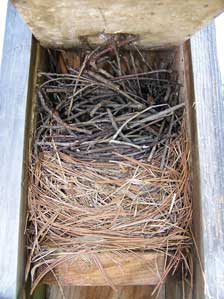
Keeping in mind “never say never or always,” I was curious about who trumps who when it comes to nestbox wars. The winning species probably depends on a number of factors, including the following. Some birds (bluebirds, titmice) will remove nesting material placed there by another bird competing for the same box. See interesting video of TUTI v. Bluebird fight inside a box.
- Aggressiveness: e.g., general nature in addition to beak size/ type. For example, the House Sparrow has an aggressive nature plus a crushing beak used to attack eggs, nestlings and adults. The House Wren has a piercing beak used to render competitor’s eggs infertile or to remove them from the nestbox. The House Sparrow generally corners it’s competitor in the nestbox, but it would be difficult for them to maneuver through the mountain of sticks left by a House Wren.
- Pressure: number of nesting sites available. If there are plenty, competition may be less. But I’m still attempting to assess who gets “first dibs.”
- Resident vs. non-resident, and timing of arrival (for non-residents). For example, if bluebirds are already building, they may run off Tree Swallows, but if the Tree Swallows got a head start, they may be able to overwhelm bluebirds.
- Timing of nest building: e.g., if one species starts nest building first, other species may not even try to take over the box.
- Time to build nest: e.g., a House Wren is fast, and can take over a box quickly. Tree Swallows take forever to construct a nest, and end up being away from the box for long periods of time, which exposes their nest site to attack and takeover.
Who wins does NOT appear to depend on:
- Bird size: e.g., the House Wren is puny, a House Sparrow is smaller than a bluebird, yet both are very successful in claiming and retaining nestboxes.
- Ability to nest in NON-cavities: e.g., both House Wrens and House Sparrows can also nest in non-cavities, but this doesn’t seem to deter them from claiming a nestbox.
- Taking these variables into consideration, here is a GENERAL order you might see when it comes to who wins control over a nestbox. (Note – if native birds are fighting over boxes, put up another one! You can also try pairing.) Note that it may be difficult to determine who ousted who, especially if the two species’ nesting material and structure are similar.
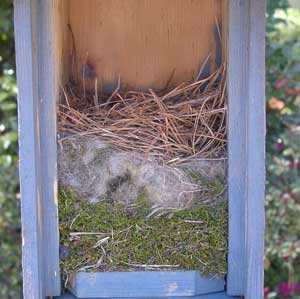
If you have two desireable species competing for a box, put up another one. However, sometimes, for some reason (territoriality?) birds often want the box the other bird is using.
-
- Starling: Aggressive, persistent, smart, large. (But can not fit in standard bluebird box with 1.5″ hole.) Can beat out HOSP. Adept at pulling nestlings out of a box. Reported to remove Flickers, and cause Wood Ducks and Kestrels to abandon a box.
- House Sparrow (HOSP): early nester, aggressive, persistent, strong crushing beak. I have only heard of two instances of House Sparrows duking it out with House Wrens. In both, the House Wrens had started a nest, but the House Sparrows won out. In one, the HOSP apparently threw the HOWR babies out of the nest. House Sparrows will beat out their cousins Eurasian Tree Sparrows. Scattered reports of House Sparrows killing House Wren adults and young.
- Woodpeckers? Not sure where they fit, but will easily eject Carolina Wrens and Chickadees, and dispatch eggs/young. Some will prey on eggs. Sometimes bluebirds attempt to take over cavities of Red-cockaded Woodpeckers. Bigger woodpeckers (e.g., Red-bellied or Red-cockaded) may usurp cavities of smaller woodpeckers (like the Downy.)
- House Wren (HOWR): Later nester, but very persistent and aggressive, will remove eggs, very young nestlings, and nesting material, and fill up boxes with dummy nests, making them unavailable to other birds of any species. If a bluebird catches a House Wren inside a box, it can “whup” them (evidence = lots of House Wren feathers left behind – Bluebars). A witness saw a HOWR beat up a nuthatch. HOWR may drive Downies away. House Wrens usually win out over Carolina and Bewick’s Wrens. Occasionally Eastern Bluebirds destroy House Wren nests.
- Bluebird: early nester, persistent. Year round residents or early arrivals get a jump. Male keeps a close eye on nest site. Eastern Bluebirds and Tree Swallows may be a draw. Mountain Bluebirds may beat out Tree Swallows unless the swallows gang up. Dottie of Carlisle PA reported a box with 4 TRES and 1 EABL egg in it, with both species going in and out.
- Tree Swallow (TRES): persistent, but usually nest later than bluebirds so blues may get first choice. Solitary swallows are much less likely to succeed at displacing bluebirds. If they arrive earlier, they may trump bluebirds, or may outnumber them (ganging up to swoop boxes.) If boxes are paired properly (5-20 feet apart) both may nest. Weigh less than bluebirds, generally do not fare well against HOSP, will enter a box claimed by HOSP. Note: TRES have been seen taking chickadee eggs out of a box, and removing bluebird eggs. Jay Brindo had a HOWR nest taken over by TRES. Bridget Mcgann on Indiana photographed TRES beating up a bluebird. James Reserve finds Western Bluebirds trump Violet-green Swallows, killing one (captured on a nestcam.) Violet-green Swallow probably similar – one study in AZ showed paired Violett’s beat Western Bluebirds 61% of the time.
- Titmouse: nests later than Carolina Chickadees, but is pretty feisty. Definitely can get driven out by HOSP and HOWR. When TUTI and CACH lay eggs in same nest, TUTI may win and CACH die (per K Kridler)
- Nuthatches? Not sure where they fit, but they have reportedly been beaten by HOWR and Bluebirds. A neighbor watched them fending off a red squirrel, and they try to intimidate other birds at feeders. I watched one refuse to leave a roost box when a pair of bluebirds were trying to kick it out as they had chosen it for their nest (see video.) Vickie Fuquay of Virginia reported bluebirds building over a nuthatch nest with eggs.
- Chickadees. Carolina chickadee: I have heard reports of them persistently and vocally bugging bluebirds that try to take over their nest, but doubt they succeeded. There is video evidence of Carolina Chickadees (nervously) removing bluebird eggs, and pecking and removing chickadee eggs from another pair. I wonder if they are more aggressive than Black-capped Chickadees.But typically, pretty much everybody kicks chickadees out, including bumblebees, although occasionally they win against bluebirds. Mountain Chickadees may lose out to House Wrens and Violet-green Swallows. Eastern bluebirds have been known to remove chickadee nestlings from a box. (BNA). Other birds will lay their own eggs on top of or alongside chickadee eggs (see photo above.) Note: A 1 1/8″ hole restrictor can be placed on a box that has at least one chickadee egg in it to protect their nest from being overtaken by larger competitors. If their nest is taken over, try moving it to a paired box (5-20 feet away) with the entrance hole facing the opposite direction (but away from prevailing winds.) Will not returned to a failed nest site to try again.
- ?Carolina Wren? Not sure where they fit, I rarely get them in nestboxes. Carolina Wrens are not known to evict chickadees.
- Prothonotary Warbler: David Gwin has found that even Chickadees and Titmouse occasionally kick Prothonotary’s out, as they are not very aggressive. However, they reportedly built a nest on top of eggs or live nestlings of another species (Carolina Chickadee) but it depends on timing – in TX, CACH nest well before PROW arrive back from migration.
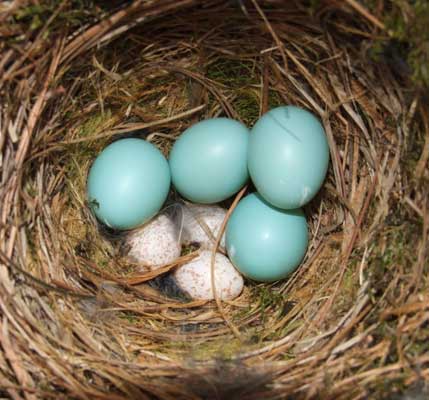
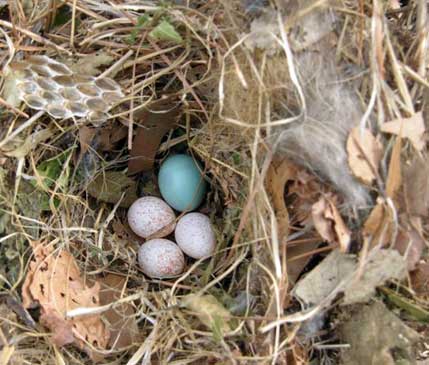
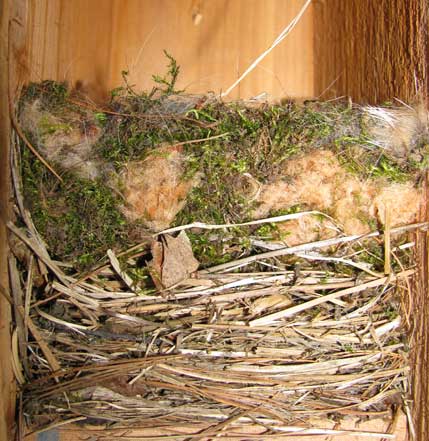
MORE INFORMATION:
- Predator and Problem ID – guide and solutions
- Video of HOWR throwing bluebird nestlings out of box
- Video of HOSP attack on another unidentified bird
- HOSP management, including identifying an attack
- Deterring HOWR
- Why don’t HOWR’s wipe out HOSP?
Life is nothing but a competition to be the criminal rather than the victim.
– Bertrand Russell
